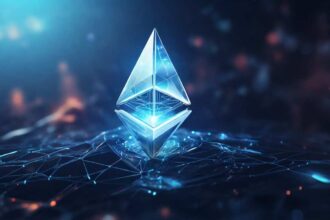The non-fungible tokens or NFTs represent a new type of ownership and artistic expression in an ever-changing world of blockchain technology and electronic currency. Fractionalization is an innovative idea that recently entered the world of NFTs. The traditional function of NFTs was to represent exclusively available and undividable digital items. It allows several stakeholders to hold a part of the digital asset.
- What Are Fractional NFTs?
- How Does Fractional NFT Work?
- What Is the Relationship Between NFT Fractionalization and Valuation?
- Increased Accessibility and Liquidity
- Liquidity Enhancement
- Market Sentiment and Perception
- Governance and Decision-Making
- What Are Some Fractional NFT Platforms?
- Can Fractional NFTs Be Reversed?
- Advantages and Disadvantages of Sharing an NFT
- Future of Fractional NFTs
- Conclusion
Fractional NFTs are based on the idea of splitting the ownership of a single NFT into tradable portions, known as fractional ownership or shares. Such fractions are therefore shared between different parties that hold percentage-wise interests in the given NFT.
Democratization of such ownership opportunities will open unique and affordable chances for everyone to have a share of the luxury value digital items such as NFTs. Fractionalization is an important solution that will help build communities and foster shared ownership among others in the decentralized digital sphere.
What Are Fractional NFTs?
One of the most innovative developments in the arena of decentralization, digital assets, and digital ownership is fractional NFT, that is., fractionalized non-fungible tokens. Fractional NFTs allow dividing ownership between several owners in various proportions and trading these fractions. Such fractions enable several people to jointly own and sell a portion of an individual’s NFT.
It improves the affordability for high–value digital assets. Thus, it allows for increased accessibility and participation of various players in the NFT market. Smart contracts on the blockchain enable the fractionalization of transactions transparently and securely. In this way, ownership is democratized since it allows more people to make investments and participate in appreciating these one-of-a-kind digital creations, cultural items, or any other NFTs that they may not be able to afford otherwise. The road to diversity and community in the digital space of ownership is through fractional NFTs.
How Does Fractional NFT Work?
Fractional NFTs, also known as fractionalized non-fungible tokens, can be seen as a method of fragmenting ownership over one NFT. To facilitate easier entry into NFT ownership, multiple persons can each acquire fractional shareholding or part ownership of a valuable or desired NFT.
This procedure normally includes a smart contract that dismembers the NFT into fungible tokens with individual proportions of the whole. Thereafter, these fractional tokens are traded to investors and other participants who get an ownership stake in the NFTs on which they are traded. The smart contract dictates ownership principles such as sharing profits, governance, and other decisions amongst fractional owners should they apply here.
These fractional NFTs are traded on Fractional NFT platforms. These platforms provide investors with the ability to purchase, sell, or trade their fragmented NFT shares in a market otherwise considered illiquid. Democratizing asset access will enable a wider range of stakeholders to benefit from trading expensive or popular digital possessions.
In addition, fractional NFTs come with added layers of complexity like the governing structures and controversies among fractional NFTs owners. However, they provide a different way of making NFTs more accessible and open to valuable virtual possessions.
Interested in learning what NFTs are, here is a guide for you.
What Is the Relationship Between NFT Fractionalization and Valuation?
Several aspects determine the relationship between Fractional NFTs and valuation as NFTs in a market depend on how they are valued. There are many ways by which fractionalization can influence the value of a particular non-fungible token:
Increased Accessibility and Liquidity
Fractionalization allows people to have fractional ownership in otherwise costly, single high-value digital assets. The broader market of buyers that this increased accessibility entails may lead to an increase in demand for the NFT, which then raises its subjective significance.
Liquidity Enhancement
Liquidity is brought into the NFT market by fractionalization. Selling or trading an NFT as a whole is often difficult because of its immeasurability and expensive taglines. Fractional ownership opens up the market of NFTs to more users by allowing them to acquire pieces instead of a full asset, which helps increase liquidity in the market due to more people entering or exiting their positions. The higher liquidity boosting increases demand which in turn, has a positive impact on the NFT’s valuation.
Market Sentiment and Perception
Market sentiment also affects how people see it and therefore perceive its intrinsic worth as an investment opportunity. However, if fractionalization gains acceptance and gets popularity among people, it might induce a positive attitude toward NFT thereby pulling a higher number of participants in the market to increase its perception. There might also be problems concerning fractionalization that could reduce the value, including problems with the government or disputes among fractional owners.
Governance and Decision-Making
Certain fractionalized NFTs have properties related to governance, which in turn allows fractional owners to collectively decide on the sale or hold of the NFT. Governance structures are a key factor affecting the potential success or failure of the company’s offerings. Investors will put their confidence in investments that come with clear decision-making processes.
Interested in learning about the top 3 NFT projects to venture into, here is a guide for you.
What Are Some Fractional NFT Platforms?
Fractional Art
A platform known as fractional art was created on the Ethereum blockchain which enables trading fractions of non-fungible tokens (NFT).
Fractionalization: This means that users can create other ERC-20 tokens representing fractional ownership interests in the NFT such that many other investors can participate and own some value associated with the digital asset.
Marketplace: This is where artists who are members of the Fractional art platform get a chance to sell their artistic assets as well and other people who love collecting such kinds of pieces are allowed to purchase them in exchange for money or virtual currency tokens.
Governance: In this regard, various governance measures have been incorporated into the platform through which fractional holders would take part in making decisions regarding their respective NFTs.
Unic.ly
The unic.ly platform allows for shared ownership in expensive digital assets such as non-fungible tokens (NFT).
Fractionalization: Therefore, users can create NFTs tokenization, and offer fractional shareholding of the same to other potential interested traders.
Trading: Unic.ly hosts a market for buying and selling fractional NFTs from users.
Liquidity Pool: It provides a liquidity pool mechanism that is aimed at increasing liquidity for fractionalized NFTs.
NIFTEX
One example is NIFTE, a distributed application for the fragmenting of non-fungible assets into divisible ERC-20 tokens.
Fractionalization Engine: Through the protocol offered by NIFTEX, an ERC 20 token is created as a representation in a fractionalized form of traded units for every NFT.
Secondary Market: There is also a secondary market for these fractionalized NFTs on this platform.
DAO (Decentralized Autonomous Organization): The DAO governance helps NIFTEX token holders engage in decisions concerning the platform.
Variable
At the onset, Rarible was just an NFT market place but it has evolved today to a platform that enables the production and trading of fractionalized NFTs
Minting: Rarible enables users to mint their NFTs and has utility in fractionalizing the respective assets.
Marketplace: The transaction and listing of fractional NFTs can occur directly on the Rarible site.
Community: Rarible’s community-oriented platform includes social interactions and engagement options for both creators and collectors.
CurioInvest
CurioInvest is a company that deals in fractional ownership of different alternative assets such as exclusive high-value NFTs among others.
Asset Variety: Additionally, CurioInvest offers Fractional ownership in other asset classes like Real estate and high-end machines.
Tokenization: Blockchain is used by a platform to tokenize its assets for purposes of fractional ownership and trading.
Investment Opportunities: Such assets can be offered to users in fractions while the purpose of the platform is to democratize alternative investment.
Interested in getting more exposure on the top NFT marketplaces, here is a guide for you.
Can Fractional NFTs Be Reversed?
The concept of reversing fractional NFTs can be approached from different angles, so let’s explore a couple of aspects:
Tokenization Reversal
Not Typically Reversible: It is therefore impossible to go back and revert the process once an NFT becomes broken down into smaller ERC-20 fungible tokens. This is so because the fractional tokens are practically autonomous entities holding individual values and ownership registers. These fractional tokens remain linked to the original NFT, which may still exist although associated with the ownership of such tokens.
Decentralized Nature: Smart contract-governed processes like fractionalization are common in decentralized platforms. The fact that blockchain technology is decentralized and immutable also ensures that this includes transactions like giving a new company token, which will be included as a permanent record on the blockchain.
Ownership Reversal
Ownership Changes: Secondary market trading in fractional NFTs can also lead to changes in ownership. Nevertheless, reversing ownership concerning recovering fractions from different owners and pooling them all back into one ownership body is not that straightforward.
Governance Mechanisms: Some of these fractional NFT platforms even offer a collective decision-making mechanism for the token holders. For instance, an option to sell or transfer all fractions would possibly involve one shareholder only as a result of certain governance rules in force within the platform.
The irreversibility of fractionalization is noteworthy and plays an integral part in making blockchain platforms transparent and reliable. Once entered into the blockchain, they cannot be tampered with or manipulated.
A “reversal” or consolidation of ownership may require collaboration between the existing fractional owners or following the platforms’ governance rules if any. Every platform usually will have the rules and mechanism to handle such occasions. One should refer to the specific terms and conditions of the particular platform.
Advantages and Disadvantages of Sharing an NFT
Sharing an NFT, either through fractionalization or other means, has its own set of advantages and disadvantages:
Advantages of Sharing an NFT
Increased Accessibility
Fractionalization has made sharing of an NFT, which is one of the most crucial attributes, inexpensive for many, who would otherwise find it very expensive. Inclusiveness fosters a broader-based network of stakeholders.
Liquidity
Liquidity can also be boosted by adopting fractional ownership. Fractionally traded stocks help accommodate both these groups by enabling people to buy and sell fractions as per their desires.
Collective Ownership
For example, the sharing of an NFT enables a group of individuals to jointly hold and savor a worthwhile digital entity. This shared experience, discussion, and collaboration among fractional owners make it a true community.
Diversification
Investors can own fractions of multiple HNFTs and thus, diversify their portfolios.
Democratization
Democracy is associated with sharing NFTs. It increases the number of people who can own distinctive digital content that may be owned by only a few people.
Disadvantages of Sharing an NFT
Complex Governance
One example of this is managing fractional ownership, which may often become complicated, especially during the decision-making process. Well-structured governance must account for voting, disputes, and other decision processes that are required by fractional owners.
Potential for Disputes
Similarly, since fractional ownership involves a group of owners in the creation of an NFT, this may result in disputes on what to do with it in terms of selling, retaining, or changing it. Sometimes conflicts are hard to resolve, so certain ways of governing may have to be adopted.
Technical Challenges
Smart contracts and blockchains ensure the fractionalization process. Fractionalized NFTs may face many risks from various technical issues like vulnerability and protocol modifications which directly affect their security and operational aspects.
Reduced Control for Owners
This implies that in fractional ownership, each owner exerts a less personal grip on NFTs. However, in most cases, decisions regarding the NFTs’ future involve consent or complying with the governing rules which might be far from what each owner would want.
Market Perception
Some people might see fractionalized NFTs differently as compared to whole NFTs, depending on their status i.e., they are collectors or investors. The perceived value of owned NTF might be greater than that of fraction, which has the potential to drive the market.
Future of Fractional NFTs
Fractional NFTs have a promising future in the development and expansion of digital assets. With time and the advancement of blockchain technology, fractionalization will be more defined and prevalent in NFTs. Shared ownership will create a wider and fairer environment for participating in sought-after digital elements.
Such a change in trend is likely to create more avenues for investments such as decentralized applications, investment instruments, and fractional NFT. Further, improvements in governance mechanisms will have to deal with complexities including management of decisions among fractional owners for fairness.
DAOs and other governance models will help improve the management of fragmented assets with a sense of belongingness among citizens. Thus, it can be said that fractional NFTs will redefine the nature of ownership, trade, and collaboration within the digital art and collectible industry, leading to an open and vibrant NFT domain.
Conclusion
The fractional NFT is one of the newest techniques for giving ownership shares in digital property. These innovations allow individuals to tokenize NFTs into tiny fractions that anyone can easily buy and own, making these expensive products more inclusive. Liquidity is improved, it promotes community engagement, and it creates additional investment avenues by enabling the sharing of NFTs. On the other hand, governance issues and possible contention among co-owners should be addressed by appropriate regimes. With time the future of fractionalized non-fungible tokens can reshape the world ownership patterns of digital art and collectibles.



















